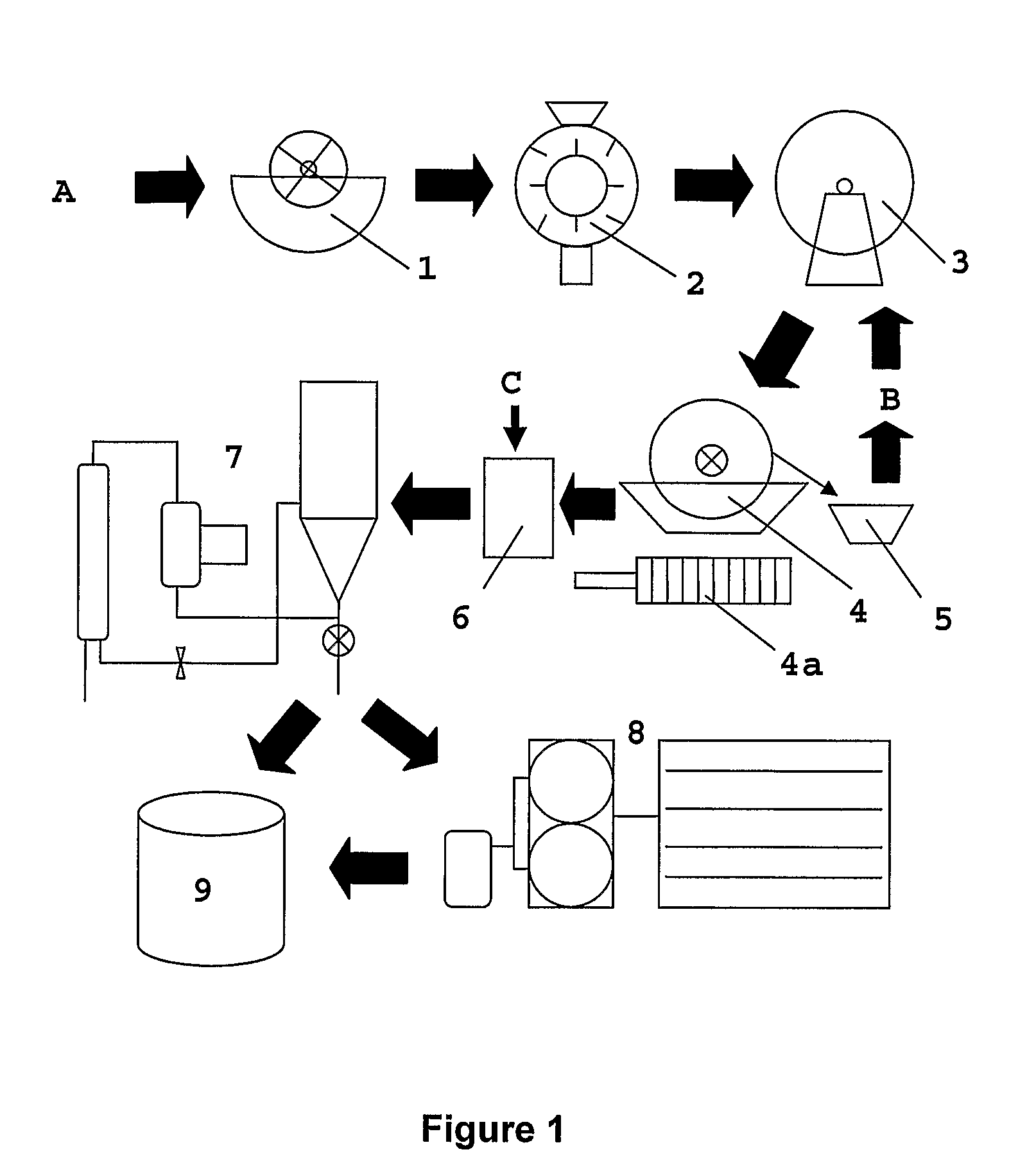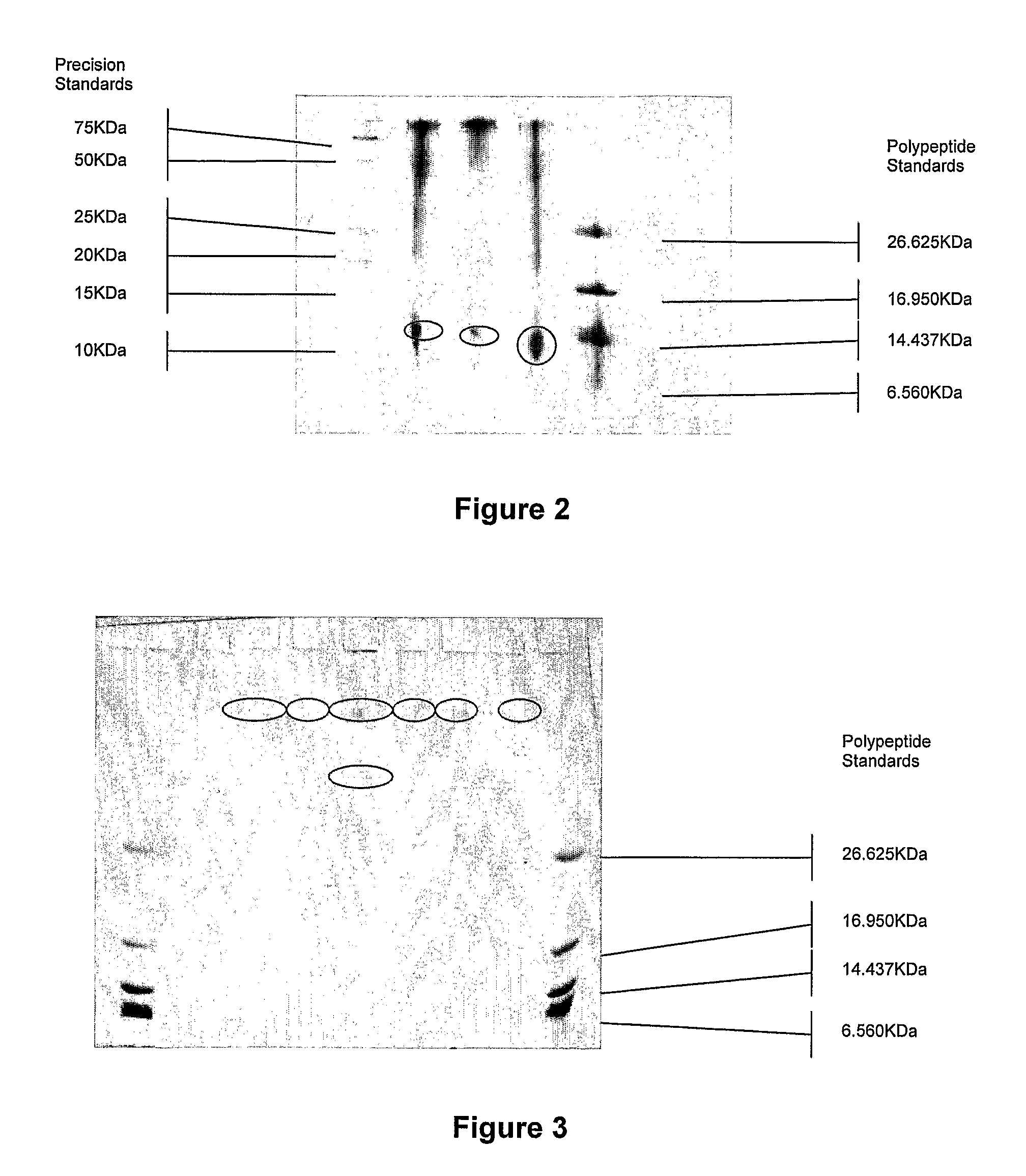Method for separating keratinous proteins from materials
a technology of keratinous proteins and keratin, which is applied in the direction of animal/human proteins, immunoglobulins, peptides, etc., can solve the problems of high production of keratinous gases in an industrial process, and achieve the effect of reducing the risk of hydrogen sulfide or sulfur dioxid
- Summary
- Abstract
- Description
- Claims
- Application Information
AI Technical Summary
Benefits of technology
Problems solved by technology
Method used
Image
Examples
example 1
[0082]FIG. 1 illustrates schematically a process of one embodiment of the invention.
[0083]The embodiment illustrated in FIG. 1 involves extraction of keratinous proteins from feathers A. The feathers A, are washed and scoured in washing apparatus (1) to remove blood, dirt and other contaminants. As a washing apparatus, a stainless steel tumbling vessel of 250 L capacity manufactured by Dose GmbH was used. The washed feathers are then fragmented, or milled, in a mill (2). The mill used was a butcher's mincing machine supplied by Butcher's Suppliers Pty Ltd of Australia.
[0084]The milled feather product is then transferred into a digestion vessel (3) in which the milled feathers are reduced to produce a product containing a solution of keratinous proteins, and undissolved solids. The digestion vessel is another Dose 250 L stainless steel tumbler. The product mixture is transferred to a 0.87 m2 rotary drum vacuum filter (4) supplied by Chemical Plant and Engineering Pty Ltd for separati...
example 2
[0091]The following process was conducted in the apparatus illustrated in FIG. 1 and described above.
[0092]10 kg of feathers were washed and scoured in the washing apparatus using water and surfactant Baymol A™ from Bayer. The washed feathers were wet milled in the mill, and the minced product transferred to the rotary drum mixer. In the rotary drum mixer, the milled feathers were digested with a solution of 320 grams of sodium sulfide (calculated as 100% Na2S) in 100 litres of water at 25° C. (concentration therefore 3.2 g / l). The pH of the reduction mixture was adjusted to pH 13 with sodium hydroxide.
[0093]The milled feathers were subjected to digestion over a period of 45 minutes. Following digestion, the product was immediately transferred to the filtration apparatus in which the solids were separated from the solution containing keratinous proteins. The separation stage was conducted over a period of 1 hour.
[0094]The solution of keratinous proteins is transferred to an oxidatio...
example 3
[0096]The following process was conducted in the apparatus illustrated in FIG. 1 and described above, with the exception that the wool was not fragmented in a mill following washing.
[0097]In a rotary drum mixer, 1 kg of scoured wool was digested with a solution of 100 grams of sodium sulfide (calculated as 100% Na2S) in 20 litres of water at 25° C. (concentration therefore 5 g / l). The pH of the reduction mixture was adjusted to pH 13 with sodium hydroxide.
[0098]The wool was subjected to digestion over a period of 24 hours. Following digestion, the product was immediately transferred to the filtration apparatus in which solids were separated from the solution containing keratinous proteins. The separation stage was conducted over a period of up to 60 minutes.
[0099]The solution of keratinous proteins is transferred to an oxidation vessel. In this vessel 30% hydrogen peroxide was added to the solution until the pH had dropped to 11.3. No precipitation occurred before the oxidation, as ...
PUM
| Property | Measurement | Unit |
|---|---|---|
| Temperature | aaaaa | aaaaa |
| Temperature | aaaaa | aaaaa |
| Time | aaaaa | aaaaa |
Abstract
Description
Claims
Application Information
 Login to View More
Login to View More - R&D
- Intellectual Property
- Life Sciences
- Materials
- Tech Scout
- Unparalleled Data Quality
- Higher Quality Content
- 60% Fewer Hallucinations
Browse by: Latest US Patents, China's latest patents, Technical Efficacy Thesaurus, Application Domain, Technology Topic, Popular Technical Reports.
© 2025 PatSnap. All rights reserved.Legal|Privacy policy|Modern Slavery Act Transparency Statement|Sitemap|About US| Contact US: help@patsnap.com


